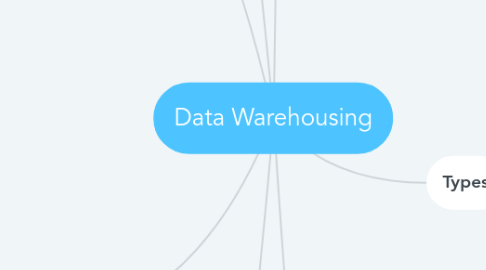
1. Key Operational data
1.1. Current and Histtorical
1.1.1. Is
1.1.1.1. Accesed
1.1.1.2. Organized
1.1.1.2.1. Result
1.1.1.3. Integrated
2. Metadata
2.1. Describe
2.1.1. Structure of data
2.1.2. Meaning about data
2.2. Type
2.2.1. Syntactic metadata
2.2.1.1. Data describing the syntax of data
2.2.2. Structural metadata
2.2.2.1. Data describing the structure of the data
2.2.3. Semantic metadata
2.2.3.1. Data describing the meaning of the data in a specific domain
2.2.4. Traditional metadata
2.2.4.1. Approach
2.2.4.1.1. Ontology
2.2.4.1.2. Metadata registries
2.3. successful metadata-driven enterprise
2.3.1. Effectiveness,
2.3.2. Extensibility,
2.3.3. Reusability
2.3.4. Interoperability,
2.3.5. Efficiency and performance
2.3.6. Evolutiont
2.3.7. Etc
2.4. Provide context to the reported data
3. Process
3.1. Components
3.1.1. Data sources
3.1.1.1. OLTP or ERP system
3.1.1.2. External data providers
3.1.1.3. Multiple independent operational “legacy"
3.1.2. Data extraction and transformation
3.1.2.1. custom-written
3.1.2.2. commercial software called ETL
3.1.3. Data loading
3.1.3.1. staging area
3.1.3.1.1. transformed and cleansed
3.1.4. Comprehensive database
3.1.4.1. Support all decision analysi
3.1.4.2. Summarized and detailed information
3.1.5. Metadata
3.1.6. Middleware tools
3.1.6.1. Enable access to the data warehouse
4. Data
4.1. Integration
4.1.1. Permit data to be accessed
4.1.2. Accessible to an array of ETL
4.1.3. Analysis tools and the data warehousing environment
4.1.4. Technologies
4.1.4.1. EAI
4.1.4.2. SOA
4.1.4.3. ETL
4.1.4.4. EII
4.2. ETL
4.2.1. Extraction
4.2.1.1. Reading data from one or more databases
4.2.2. Transformation
4.2.2.1. Converting the extracted data
4.2.3. Load
4.2.3.1. Putting the data into the data warehouse
4.3. Representation in DW
4.3.1. Dimensional modeling
4.3.1.1. means to be implemented
4.3.1.1.1. Star schema
4.3.1.1.2. Snowflakes schema
4.4. Analysis
4.4.1. OLAP
4.4.1.1. carry out day-to-day business functions
4.4.2. OLAP
4.4.2.1. Support decision making
4.4.2.2. Provide answers to business
4.4.2.3. Management queries
4.4.2.4. Variations
4.4.2.4.1. ROLAP
4.4.2.4.2. MOLAP
4.4.2.4.3. HOLAP
4.5. Real-Time
4.5.1. Identify problems
4.5.2. Current state of business
4.5.3. assist on strategic and tactical decisions
5. Characteristics
5.1. Subject Oriented
5.1.1. organized
5.1.1.1. detailed subject
5.1.1.1.1. determine
5.1.1.2. Product orientation
5.1.1.2.1. update the database
5.2. Integrated
5.2.1. subject orientation
5.2.2. Data from different sources
5.2.2.1. Into a
5.2.2.1.1. Consistent format
5.3. Time Variant
5.3.1. Detect
5.3.1.1. Trends
5.3.1.2. Deviations
5.3.1.3. Long Term
5.3.1.3.1. Forecasting
5.3.1.3.2. comparisons
5.3.1.3.3. leading to decision making
5.4. Non Volitile
5.4.1. Changes
5.4.1.1. New Data
5.4.2. Obsolet Data
5.4.2.1. Discarded
5.5. additional characteristics
5.5.1. Web based
5.5.2. Relational/multidimensional
5.5.3. Client/serve
5.5.4. Real time
5.5.5. Include metadata
6. Types
6.1. data marts
6.1.1. Smaller
6.1.2. particular subject or department
6.1.3. Types
6.1.3.1. Dependent
6.1.3.1.1. Created directly from the data warehouse
6.1.3.1.2. Consistent data model
6.1.3.1.3. Providing quality data
6.1.3.1.4. Data warehouse must be constructed firs
6.1.3.1.5. End user view same version of the data that is accessed by all other data warehouse users
6.1.3.2. Independent
6.1.3.2.1. Designed for
6.1.3.2.2. Source is not an EDW
6.2. operational data stores (ODS)
6.2.1. provides a CIF
6.2.1.1. Interim staging area for a DW
6.2.1.2. Updated throughout the course of business operations
6.2.2. short-term decisions
6.2.2.1. Mission-critical applications
6.2.3. Consolidates data from multiple source
6.2.4. Provides a near–real-time
6.2.5. Integrated view of volatile
6.2.6. Current data
6.2.7. ETL = DW
6.2.8. Created when operational data needs to be analyzed multidimensionally
6.3. enterprise data warehouses (EDW)
6.3.1. Large-scale data warehouse
6.3.2. Integration of data
6.3.3. Provide data for many types of DSS
6.3.3.1. CRM
6.3.3.2. SCM
6.3.3.3. BPM
6.3.3.4. BAM
6.3.3.5. PLM
6.3.3.6. KMS
6.3.3.7. Revenue management
7. Architectures
7.1. Two-Tier
7.1.1. The data warehouse
7.1.2. Data acquisition software
7.1.3. Client software
7.1.4. DSS software = DW
7.1.5. Advantages
7.1.5.1. More economical
7.1.5.2. Can have performance problems for large data warehouse
7.2. Three-tier
7.2.1. data and the software
7.2.2. data warehouse
7.2.3. DSS/BI/BA engine
7.2.4. advantage
7.2.4.1. Separation of the functions of the data w
7.2.4.2. Eliminates resource constraints
7.2.4.3. It is possible to easily create data marts
7.3. Alternative
7.3.1. Independent data marts
7.3.1.1. simplest and the least costly
7.3.1.2. operate independently
7.3.2. Data mart bus architecture
7.3.2.1. Data are linked among the individual marts
7.3.3. Hub-and-spoke architecture
7.3.3.1. Attention on building a scalable and maintainable infrastructure
7.3.3.2. Easy and customization of user interfaces and reports
7.3.3.3. Centralized data warehouse
7.3.3.4. Dependent data marts

